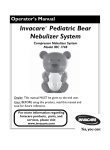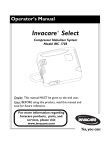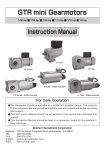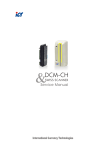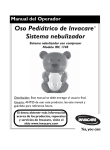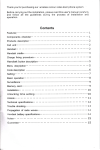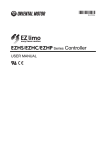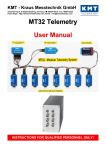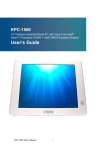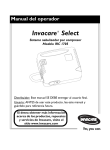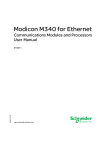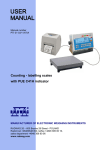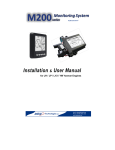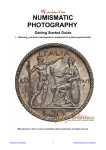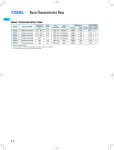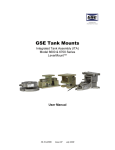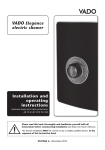Download Instruction Manual Safe Operation
Transcript
GTR MID GEARMOTORS 1/8 Hp ■ 1/4 Hp ■ 1/2Hp ■ 1 Hp ■ 2 Hp ■ 3 Hp Instruction Manual Safe Operation ●The Gearmotor should be operated by a skilled and qualified person. The contents of this Instruction Manual should be carefully read and understood before operating this product. ●This Instruction Manual should be accessible to the person who operates this product. ●This Instruction Manual should be kept in a convenient place for the operator's easy reference. Manufacturer Brother International Corporation Address 100 Somerset Corporate Blvd, Bridgewater, NJ 08807 TEL 866-523-6283 FAX 908-575-3743 E-MAIL [email protected] WEB www.brother.com Thank you for your purchasing this product. Potential injuries and/or damage caused by mishandling equipment are classified into two categories, "Danger" and "Caution". The definitions of the classifications are given below with the corresponding graphic symbols. ! Mishandling the equipment may result in a dangerous situation and ! Mishandling the equipment may result in a dangerous situation and Danger CAUTION may lead to serious or fatal injury to personnel. may lead to medium to light injury or damage to the equipment. Please be aware that even items marked with "CAUTION" may cause fatal accidents. Therefore, be sure to follow the instruction, for every item described is very important. ! DANGER ●Use an explosion-proof motor when any explosive or flammable gases are present. Failure to observe this warning may cause explosion, spark, fire, electric shock, physical injury, and/or damage to the equipment. ●People in charge of transportation, installation, wiring, operation, maintenance, and inspection of the equipment should have sufficient knowledge and technical skill to install electrical and mechanical products. Failure to observe this warning may cause explosion, spark, fire, electric shock, physical injury, and/or damage to the equipment. ●Do not repair or wire the equipment with the electric power on. Cut the power before working on this product. Failure to observe this warning may cause electric shock. ●If the equipment incorporating this gearmotor is used in a system for human transport, furnish it with sufficient protective devices for safety and follow any and all local or national codes. Failure to observe this warning may cause physical injury, death and/or damage to the equipment. ●If the equipment is to be used to drive an elevator, be sure to furnish it with safety devices to prevent the elevator from accidentally falling. Failure to observe this warning may cause physical injury and/or damage to the equipment. ●Be sure not to get water or oil/grease into the brake unit. Failure to observe this warning may cause brake failure by decreasing brake holding torque. ! CAUTION ●Do not use this gearmotor under conditions other than specified on the nameplate or product specifications. Failure to observe this warning may cause electric shock, physical injury and/or damage to the equipment. ●Do not insert your fingers or any other object into the terminal box, lead wire exit, fan cover, or any other aperture of the gearmotor. Failure to observe this warning may result in electric shock, physical injury, fire and/or damage to the equipment. ●Do not use a damaged gearmotor. Failure to observe this warning may result in physical injury and/or fire. ●Do not remove the nameplate. ●The manufacturer will not warrant and will not be responsible for any product modified or repaired by the user. 2 Contents 1Check When Unpacking P.3 7 Operation P.20 2Transportation P.3 8 Inspection and Adjustment P.22 3Installation P.4 9 Trouble Shooting P.26 4Connecting with Other Equipment P.5 10 Disposal P.27 5Direction of Rotation P.12 11 UL/CSA/CE P.28 6Wiring P.13 12 Warranty P.29 1 Check When Unpacking When unpacking the carton, please check the following items. If you have any problems or questions, please contact the dealer from which the product was purchased or Brother International Corp sales office. ! CAUTION Check whether the product is the product you ordered. Installing the wrong gearmotor on your equipment may cause physical injury and/or damage to the equipment. (1)The ordered product(s), the contents of the box or crate, and the rating indicated on the nameplate are correct. (Type,Reduction Ratio, RPM, Horsepower or Watts, Voltage, Frequency, etc.) (2)No accidental damage to the product during transportation has occurred. (3)Screws or nuts are not loose. (4)In case of a brake equipped gearmotor, be sure the rectifier is enclosed. (5)In case of a 1/8 Hp single-phase motor be sure the capacitor is enclosed. (6)In case of F or F3 series hollow bore/shaft mount type be sure the bore safety cap is enclosed. 2 Transportation ! DANGER When a product is lifted for transportation, be careful. If a product is dropped and lands on any part of your body it may cause serious injury. 3 ! CAUTION ●Avoid dropping products during transport. When an eyebolt or eyeplate is provided on a gearmotor or reducer, confirm it is secure before using it. After installing the gearmotor or reducer in the equipment do not hoist the entire machine using the eyebolt or eyeplate. Failure to observe this warning may cause physical injury and/or damage to the equipment. ●Before lifting the product confirm it's weight using the packing box, product catalog, or by weighing it. Use a lifting device that has enough capacity to handle the weight of the gearmotor. Failure to observe this warning may cause physical injury or damage the equipment. ●If the product is packed in a wooden crate, please do not use a forklift to lift it from the bottom. The crate is not designed for use with a forklift in that manner. If using a forklift, please use a belt to lift the wooden box from the top. 3 Installation Proper installation of a product will ensure reliable service and maximum life. ! CAUTION ●Do not place any flammable object near the gearmotor. Failure to observe this warning may cause fire. ●Do not allow interference with the ventilation of the gearmotor. Be sure to observe the spacing requirements for adequate air flow around the gearmotor. In the case of a fan cooled model, do not block the vent holes on the fan cover. Failure to observe this warning may result in abnormal overheating and/or injury or fire. ●Do not step on a gearmotor. Do not use a gearmotor as a grip to hoist yourself onto a machine. Failure to observe this warning may cause physical injury. ●Do not touch the edge of the shaft of the gearmotor or the key groove of the bore with your bare hands. Failure to observe this warning may cause physical injury. ● Food machine regulations may prohibit the possibility of oil or grease getting into the food area. If this is the case, please use a drip pan to prevent lubrication from getting into the food area. Alternatively, please request that appropriate food grade lubricants are applied. ●Leaking oil may cause products to fail. ●Vibration resulting from improper installation of the gearmotor or from other sources should be under 0.5G. (1)Proper location for installation Ambient Temperature: 14 to 104F (-10℃ to 40℃) Ambient Humidity: 85% max. Altitude: Sea level to 3280 feet (1,000m max.) Environment: Standard Type: Well ventilated free from vapor and dust. IP-65 Type: Well ventilated free from vapor Note: In a hazardous environment where any explosive and flammable gases exist use an explosion-proof motor. Installation Location: Indoors (2)Direction of Installation This product can be installed in any direction and any angle due to a grease lubrication system. 4 (3)Method for Installation Tightening Torque for Torque Arm a) Mounting a foot or flange type with a shaft. Fixing Hole Metric Tightening Fixing Inch Bolt Tightening Size Torque ●Secure the product with four bolts on a flat and Metric Bolt Torque (N- Hole machined surface free from vibration. (mm) Size m) Inch (in) ●Roughness of the mounting surface should be less than 5.5 M5 2.9 0.20 3/16-18 25 0.3mm. 6.5 M6 4.9 0.25 ¼-20 43 8.5 M8 13 0.33 5/16-18 115 such that it can handle the weight of the gearmotor or 11 M10 25 0.43 3/8-16 220 reducer. 13 M12 44 0.51 7/16-14 390 15 M14 69 0.59 7/16-14 390 18 M16 108 0.71 5/8-11 955 22 M20 294 0.75 5/8-11 2600 b) Mounting a hollow bore/shaft mount type. ●The driven shaft should be large enough and supported ●Forces other than the turning or reactive force should not be imposed on the torque arm. ●For frequent start/stops or forward/reverse secure the torque arm with bolts to keep it axially secure. (4) Ventilation Around the Gearmotor Minimum Dimension”A’ for Proper Ventilation Standard Motor IP-65 Motor 1 Phase, 3 Phase 3 Phase Horsepower Brake Brake Motor Motor Motor Motor 1/8 Hp 64 64 64 64 ¼ Hp 79 79 79 102 ½ Hp 79 79 79 116 1 Hp* 79 79 79 137 2 Hp* 101 101 101 n/a 3Hp* 101 101 101 n/a * The 1 Hp, 2Hp, and 3 Hp are not available in 1 Phase. (in-lb) Any Reducer Type Applies G3, H2, F, or F3 Note: The dimension “A’ is the space required for ventilation and for easy removal of the fan or brake cover and adjustment of the brake gap “g” for brake equipped gearmotors. Gearmotors should be mounted to allow ventilation and free air flow around the entire motor diameter. Good ventilation prolongs product life. 4 Connecting With Other Equipment ! CAUTION ●When connecting the gearmotor to a load with a chain or belt, make sure of the shaft parallel alignment is precise. Make sure the belt/chain tension is properly adjusted and pulleys or sprockets are parallel. ●When direct coupling, make sure the concentric alignment of shafts is precise. ●Before operation, make sure the set screws for the sprockets, pulleys or coupling are securely tightened. Failure to observe this warning may cause serious injury and/or damage to the equipment. ●Safety guards should be furnished around rotating parts and securely in place before starting the equipment. ● Do not over tension chain or belts. Damage to the gearmotor may occur due to excessive overhung load. ● Avoid excessively rigid direct couplings as damage may occur to the bearings due to high overhung load. 5 1Direct Connection Connect the reducer to the other equipment precisely, so that the center of the shaft of both machines will be fully aligned. ●The displacements δ and θ should be minimized as much as possible. ●The displacements δ and θ differ according to the type of coupling. They should be within the allowable value defined by the respective manufacturer. ●Reference: In case of coupling via chain, δ should be within 2% of the roller chain pitch and δ should be within 1°. 2 Attaching Chains, V-Belts, Gears, etc. (1)The center of the shaft of the reducer and that of the other equipment should be parallel. (2)The tension of Chains of V-Belts must be perpendicular to the center of the shaft. (3)Excessive tensioning of the chain or V-belt may result in damage to the bearings of the shaft. (4)If the chain is too loose (or slack), shock loading will occur when the drive shaft starts rotation. This can result in damage to the reducer and/or the equipment. Therefore, adjust the tension of the chain properly. Proper Installation ● The tension of V-belt and chain are properly set. ● The pulley and sprocket are properly positioned on the gearmotor shaft. The chain/V-belt is as close to the gearmotor output shaft bearing as possible. This minimizes overhung load and promotes longer bearing life. Improper Installation ● The Chain is too loose. ● The sprocket is applied to the shaft improperly. The chain or V-belt is set too far from the gearmotor output shaft bearing. This may lead to excessive overhung load (OHL) and shortens bearing life. 6 3 Attaching/Detaching a Driven Shaft to/from F or F3 Type Hollow Shaft ●Attaching a Driven Shaft to the Reducer Hollow Shaft (1)Apply an extreme pressure agent such as molybdenum disulfide on the surface of driven shaft and the bore of the hollow shaft to avoid seizing. (2) If the load is uniform (low impact) a loose fit is recommended for the tolerance of driven shaft. (3) If a shock load or heavy radial load will be applied to the shaft, the fit should be tighter. (4) If the fit is tight tap on the end of the hollow drive shaft gently with a plastic or wooden hammer. Do not to hit the gear casing. (5) If the fit is extremely tight, smooth insertion can be achieved if you prepare a jig shown in the figure below. (6) The length of the driven shaft and the fixing key should be positioned within the space where the bore tolerance is tight (The key should not be seated in the central relief area where the bore is larger). (Spacer, nut, bolt, key and jig parts are not supplied by Brother) ●Connecting Reducer with Driven Shaft (Spacer, nut, bolt, key and jig parts are not supplied by Brother) (Note: Excessive tightening of the bolt may cause the deformation of the snap ring.) 7 (End plate and bolt parts are not supplied by Brother) ! DANGER A plastic bore cover is supplied with each FS, F2S, or F3S type unit to cover the exposed rotating bore. If you cannot secure the safety cover supplied, please prepare a cover yourself. Failure to cover the exposed rotating bore may result in damage to the equipment or injury. (Spacer, positioning spacer, bolt and snap ring are not supplied by Brother) Note) The positioning spacer should not have a tight fit. It should have a loose fit and be concentric such that it does not interfere with the I.D. of the bore as it rotates. Excessive tightness or inaccuracy of the spacer's diameter may be a cause of rubbing interference with the bore. The positioning spacer is usefull when the resulting position of the driven shaft is not known. In case the length of the driven shaft is precisely known, the positioning spacer is not necessary. A properly applied positioning spacer does promotes easier removal of the shaft from the bore. 8 ●Recommended Size for Securing Parts Inch Dimension Bore Metric Dimension Bore Bolt Bore Spacer O.D. I.D. T (in) (in) (in) 1/4-20x1.25 0.73 0.28 1/4-20X0.75 1/4-20x1.25 0.98 1.2500 5/16-18X0.75 5/16-18x1.5 1.4375 3/8-16X1.25 1.6875 Bolt Bore Spacer O.D. I.D. T (mm) (mm) (mm) M6X30 19.5 7 3 M6X16 M6X30 24.5 7 4 30 M8X20 M8X40 29.5 9 5 0.188 35 M10X25 M10X40 34.5 11 5 0.43 0.250 45 M10X25 M10X50 44.5 11 5 1.92 0.51 0.250 50 M12X30 M12X60 49.5 13 6 1.98 0.51 0.250 55 M12X30 M12X60 54.5 13 6 (mm) Internal External 0.125 20 M6X16 0.28 0.125 25 1.23 0.35 0.188 3/8-16X1.75 1.42 0.43 3/8-16X1.25 3/8-16X2 1.67 1.9375 7/16-14X1.25 7/16-14X2.5 2.0000 7/16-14X1.25 7/16-14X2.5 (mm) Internal External 0.7500 1/4-20X0.75 1.0000 Figure- 5 Recommended Size of Securing Parts 9 Recommended Dimensions of the Shaft from the Shoulder Inch Dimension Bore Bore Metric Dimension Bore Shaft (Inch Dimension) Diameter Bore O.D. L1 L2 L3 L4 Key Tap (in) (in) (in) (in) (in) (in) T 0.7500 0.7500 in +0.0/-0.0008 0.945 3.125 1.500 0.1875 0.1875 1.0000 1.0000 in +0.0/-0.0008 1.063 3.938 2.000 0.2500 0.2500 1.2500 1.2500 in +0.0/-0.0008 1.299 4.000 3.375 1.4375 1.4375 in +0.0/-0.0010 1.496 4.500 1.6875 1.6875 in +0.0/-0.0010 1.969 1.9375 1.9375 in +0.0/-0.0010 2.0000 2.0000 in +0.0/-0.0012 (Inch) Diameter Shaft (Metric Dimension) (Metric) O.D. L1 L2 L3 L4 Key Tap (mm) (mm) (mm) (mm) (mm) (mm) T 1/4-20X0.50 20 20 h7 24 80 30 6 6 M6X12 1/4-20X0.50 25 25 h7 27 100 37.5 8 8 M6X12 0.2500 0.2500 5/16-18X0.63 30 30 h7 33 102 45 8 8 M8X16 2.938 0.3750 0.3750 3/8-16X0.75 35 35 h7 38 117 52.5 10 10 M10X20 5.375 3.375 0.3750 0.3750 3/8-16X0.75 45 45 h7 50 137 67.5 14 14 M10X20 2.165 5.375 3.938 0.5000 0.5000 7/16-14X1.0 50 50 h7 55 138 75 14 14 M12X24 2.402 7.125 4.000 0.5000 0.5000 7/16-14X1.0 55 55 h7 61 182 82.5 16 16 M12X24 Note: Refer to the product catalog for Dimensions L and P. T Shoulder L4 L3 L2 Figure-6 Recommended Dimensions of the Driven Shaft Designing your Own Shaft The usable key length “L3” should be greater than 1.5X the diameter of the driven shaft. The Key should be engaged with at least half of the length L1. The minimum length of shaft engaged inside the bore is approximately (L - L1) + ((L1-P)/2). For dimensions L and P refer to the product catalog, the www or request a drawing from Brother or your Brother distributor. The recommended dimension L2 is not essential. If your application requires a different length or if you prefer a different method of securing the shaft, it may be acceptable for your application. 10 Removing the Shaft from the Hollow Bore. Avoid applying excessive force to the casing and/or the hollow shaft. Smooth detachment can be obtained by using a jig as shown in the figure below. Figure-7 Jig for Removing the Shaft (Spacer w/ tap, disk, bolt and snap ring are not supplied by Brother) Attaching a Motor to a NEMA 56C Reducer ●Attaching Procedure (1)Confirm the key is securely inserted in the key slot of the motor input shaft (2)Align the keyway of the motor with the keyway of the reducer input bore. Gently insert the shaft into the reducer bore. (3)Confirm the motor shaft is securely inserted with the key fully engaged. (4) Secure the motor to the reducer using 4 flange bolts. (bolts not provided by Brother) ●Cautions when Attaching the Motor (1)Wipe off any rust and dust and apply and anti-seizing agent to the motor shaft. (2)When inserting the motor shaft, do not hit the motor or reducer with a hammer, nor forcibly insert the motor shaft. (3) Take advantage of the tightening force of the bolts to fully insert the shaft if required. Failure to observe this warning may cause damage to the bearing and/or abnormal noise (4) Observe the motor weight limit guidelines shown in the Table. ●Motor Mass Limit Guideline ℓ (in) : Length from reducer flange to center of motor W (lb): Weight of the motor in lbs. Horsepower (4 Pole, Induction motor) 1/8 Hp, ¼ Hp ½ Hp 1 Hp 2 Hp 3 Hp ℓ x W =M M < 240 in-lb M< 275 in-lb M< 300 in-lb M< 735 in-lb M< 825 in-lb (1)The limit of vibration that a gear reducer can withstand is 0.5G. If the vibration is greater than 0.5G, or if the motor mass limit is above the “M” limitation, the casing of the reducer and/or the reducer flange may be damaged. The motor may fall off the reducer and cause injury of damage the equipment. The motor should be supported by a separate device supplied by the user for safety. (2)Before using other manufacturer’s motors with our reducer, you should carefully read this Instruction Manual and understand the contents. The failures of a reducer caused by poor installation will not be warranted. 11 5 Direction of Rotation G3 Series 1/8 Hp ¼ Hp, ½ Hp, 1 Hp, 2 Hp, 3 Hp 5:1 to 50:1 Same Direction 5:1 to 30:1 Same Direction 60:1 to 200:1 Counter Direction 40:1 to 200:1 Counter Direction 300:1 to 1200:1 Same Direction 300:1 to 1200:1 Same Direction H2 Series 1/8Hp, 1/Hp: 5:1~60:1 & 600:1~1500:1 1/8Hp, 1/Hp: 80:1~450:1 ½ Hp, 1 HP:5:1~60:1 & 300:1~1500:1 ½ Hp, 1 Hp: 80:1~240:1 2 Hp, 3 Hp: 5:1~30:1 2 Hp, 3 Hp: 40:1~240:1 F Series 1/8Hp, ¼ Hp, ½ Hp, 1/Hp: 5:1~60:1 & 300:1~450:1 1/8Hp, ¼ Hp, ½ Hp, 1/Hp: 80:1~240:1 2 Hp, 3 Hp: 5:1~30:1 2 Hp, 3Hp: 40:1~240:1 12 F3 Series 1/8 Hp: 5:1~60:1 and 300:1~1500:1 ¼ Hp: 5:1~60:1 and 300:1~1200:1 ½ Hp: 5:1~60:1 and 300~600:1 1/8 Hp, ¼ Hp, ½ Hp, 1 Hp, 2 Hp: 80:1~240:1 1 Hp: 5:1~60 and 300:1 3 Hp: 80:1~120:1 2 Hp, 3 Hp: 5:1~60:1 6 1 Wiring Direct Connection ! DANGER ●When connecting power to the machine, follow the instructions shown on the connection diagram in the terminal box or in this Instruction Manual. Failure to observe this warning may cause electric shock or fire. ●Do not bend, pull, or tuck motor cables or lead wires forcibly. Failure to observe this warning may cause electric shock. ●Be sure to ground the earth terminal, lead wire, or lug. Failure to observe this warning may cause electric shock. ●Be sure to use the power source specified on the name plate. Failure to observe this warning may cause the motor to burnout and/or fire. ●Avoid exposing the power rectifier or capacitor to water. Failure to observe this warning may cause electric shock, damage to the equipment, or fire. 13 ! CAUTION ●1/8 Hp single-phase motors have a thermal protector is built in. If you suspect the thermal protector has tripped, switch off the power to the gearmotor and/or the machine before attempting any inspection. ● 1/8 Hp single phase motors trip temperature is 120℃±5℃, Reset temperature: under 105℃. The gearmotor will be hot if the thermal has tripped. Do not touch it with your bare hand as this will cause a burn injury. ●Do not touch the terminals or un-insulated wire connections when inspecting the insulation resistance. Failure to observe this warning may cause electric shock. ●Wires should be connected properly using the specified electrical standard or safety code. Failure to observe this warning may cause electric shock, fire or physical injury. ●Three phase motors are not equipped with thermal protective devices. Other protective devices such as a circuit breaker, fuse, or thermal relay are recommended. If “CE’ is required, a thermal relay certified for use in Europe should be used. The thermal set value should be the same as the current value specified in the name plate. Failure to observe this warning may cause damage to the equipment, electric shock, fire or physical injury. ●When operating a gearmotor not connected to a load, remove the key from the output shaft. Failure to observe this warning may cause physical injury. ●Check the direction of rotation before connecting the gearmotor to the machine's load. Rotation in the wrong direction may cause physical injury and/or damage to the equipment. ●If a 460V class inverter is used to drive the motor, use a control filter or a reactor with the inverter. Breakdown of motor insulation due to repetitive and/or extreme voltage spikes caused by normal operation of the inverter may cause damage to the equipment or fire. ●1/8 Hp single phase motors use a continuous running type capacitor. Do not substitute a starting capacitor intended for intermittent duty use. A starting type capacitor will fail when used with a permanent split capacitor motor. Use of a starting capacitor may cause damage to the equipment or failure of the capacitor. For replacement capacitors, please consult Brother or your Brother Distributor. ●Do not damage the vinyl coating of the capacitor. Damage may cause electric shock. ●Voltage drop in the wiring should be kept above 2%. Excessive length of wiring may cause a severe voltage drop. Voltage drop reduces starting capacity and may result in the load not starting. ●When reversing either a three phase or a single phase gearmotor be sure to fully stop rotation before starting in the reverse direction. Failure to completely stop before reversing may cause physical injury and/or damage to the equipment. ● Reversing a 1/8 Hp single phase PSC motor without completely stopping first may result in the motor not reversing and running in the same direction. This may cause physical injury and/or damage to the equipment. ●When using a gearmotor with a brake do not energize the brake coil continuously while the motor is not running. The brake coil of totally enclosed, fan cooled motors may rely on the motor fan for cooling. Continuous operation without the effect of the fan may cause the brake coil to burn out and/or fire. ●Totally enclosed, non-ventilated, brake-equipped motors do not rely on the fan for cooling. However, continuously energizing the coil without motor operation may still cause damage. ●If a gearmotor with a brake is used as a lift or hoist; DC Switching wiring should be used. Failure to use DC Switching may result in the lift or hoist falling and causing damage to the equipment or physical injury. 14 Special Notes About Wiring (1)The brake rectifier (A100-D90 or A200-D90) contains diodes. Improper wiring may cause a fatal short-circuit and damage or destroy the rectifier. Special care should be used when wiring. (2)The brake circuit relay for AC Switching should be an electro-magnetic switch with the capacity greater than 6A (AC200V). (3) The brake circuit relay for DC Switching should be an electro-magnetic switch with a capacity of (1A) DC110V. (4) If a noncontact relay is used an electromagnetic switch with a rated voltage of AC240V is recommended. (The capacity to switch half-wave rectification is required) (5)The direction of rotation of the output shaft varies according to the reduction ratio of the gear head. Be sure to confirm the gear ratio and the direction of rotation before wiring and starting. (6)The voltage between the capacitor terminals of a single-phase motor will become nearly twice that of the power source of the motor. Therefore be sure to insulate wires at the terminals for safety. Special Notes About Grounding ①Ground should be connected to the provided ground terminal, lead wire, or lug. ②The cross-section of the earth wire should be AWG18 (0.87mm2) minimum for 1/8 Hp, ¼ Hp, or ½ Hp motors. ③The cross-section of the earth wire should be AWG16 (1.25mm2) minimum for 1 Hp, 2 Hp, or 3 Hp motors. ④ The earth wire should be longer than the lead wire of the power source of the motor. Wiring a Gearmotor For standard gearmotors, the wiring described below is recommended. The direction of rotation referenced is as viewed from the back of the motor. Counter clockwise is the forward direction for 3-phase motors. Clockwise is the forward direction for single-phase motors. Three Phase Motors 1/8 Hp, ¼ Hp, 1/2Hp, 1 Hp, 2 Hp, 3 Hp 208/230V 460V 15 Single Phase Motors: 1/8 Hp (Permanent Split Capacitor Type) 115V 220/230V Capacitor “C” used with PSC Type Motor ●1/8 Hp single phase motors are permanent split capacitor (PSC) type motors. The starting torque of a PSC motor is 80%~85% ●PSC motors use a capacitor that remains in the circuit permanently. The capacitor needs to be mounted separately by the User. ●Be careful not to substitute an intermittent duty “starting capacitor” [mm] for use with a PSC motor. Consult brother if you are unsure. Motor Voltage Capacitor Voltage Capacitance 115V 220V 24 µFd 220/230V 440V 6 µFd ●The capacitor Voltage is 2X that of the Motor Voltage because the voltage across the capacitor terminals will become nearly 2X that of the input voltage. Single Phase Motors: ¼ Hp, ½ Hp (Capacitor Start type) 115V 16 220/230V Wiring a Gearmotor with a Brake (1)If a gearmotor is used in an application requiring fast brake response, such as a lift or hoist, "DC Switching" should be used. (2)A surge suppressor is recommended if DC Switching is required. (Varistor Voltage 423~517V) (3)The brake coil voltage for a three phase motor 208/230V/460V, or a single phase motor 220/230V is DC90V. (4) The brake coil voltage of a 1/8 Hp single phase 115V model is DC45V. (5)The required input voltage to the yellow and white wires of the rectifier (A200-D90 [A100-D45]) for single phase 115V motors is single phase 115VAC. The voltage output to the brake is DC45V. (6)The required input voltage to the yellow and white wires of the rectifier (A200-D90 [A100-D45]) for three phase motors 208/230V/460V, or for single phase 220/230V motors is single phase 220/230VAC. The voltage output to the brake is DC90V. (7)If AC switching is used, the electro-magnetic switch used in the brake circuit should have a capacity greater than 6A (AC200V). (8)If DC Switching is used, the electro-magnetic switch should have a capacity of 1A DC110V in order to shield the inductive load. (9)If a noncontact relay is used, an electro-magnetic switch with a rated voltage of AC240V is recommended (The capacity to switch half-wave rectification is required). (10)The rectifier unit contains diodes. Improper wiring may cause fatal short-circuiting and failure of the rectifier. Special care should be taken when wiring. (11)When operating the machine with inverter, refer to the "Cautions for operation with an inverter" on page 19. (12)When wiring for 460V (no inverter/VFD) the 220/230V AC voltage to power the rectifier can be tapped off the motor coil. Please see the wiring diagrams for details. (Caution: do not tap the coil voltage to power a brake coil if an inverter (VFD) is used. Brake Lag Time [sec] Type Motor Type Three Phase: 208/230/460V 1/8Hp, ¼ Hp, ½ Hp, 1 Hp Three Phase 208/230/460V 2 Hp, 3 Hp Single Phase 115V, 220/230V 1/8 Hp, ¼ Hp, ½ Hp (1) DC Switching 0.005~0.015 0.005~0.02 0.005~0.015 (2) AC Switching(A) 0.03~0.10 0.05~0.15 0.03~0.10 (3) AC Switching(B) 0.10~0.20 0.20~0.40 0.10~0.20 17 Brake Equipped Single Phase Motor: 1/8 Hp, Permanent Split Capacitor Type 115V 220/230V DC Switching AC Switching(A) AC Switching(B) Brake Equipped Single Phase Motor: ¼ Hp, ½ Hp, Capacitor Start type 115V DC Switching AC Switching (A) AC Switching(B) 18 220/230V Brake Equipped Three Phase: 1/8 Hp, ¼ Hp, ½ Hp, 1 Hp, 2 Hp, 3 Hp 208/230V 460V DC Switching AC Switching (A) AC Switching(B) Note: If an inverter (VFD) is used, the brake rectifier cannot be powered using the output side of the inverter. Please see the special inverter (VFD) wiring diagrams. The above diagrams are not suitable. 5 Cautions for Operation with an Inverter (VFD) (1)Compared to operation using a general power source, higher temperature rise, noise and vibration may be observed when using an inverter. (2) Low speed (low frequency) operation naturally reduces the cooling effect of the fan. This may cause abnormal temperature rise. Please use caution and check to if the surface temperature remains below allowable levels (176F, 80C) (3)When driving a gearmotor equipped with a brake, the brake may malfunction due to voltage drop caused by normal operation of the inverter (VFD) if the rectifier is powered by the output side of the inverter(VFD). To avoid this, it is imperative to bypass the inverter when wiring the brake. See the special wiring diagrams for use with inverters (VFd) in this manual. (4) When using a 460V inverter (VFD), it is recommended that a suitable filter or reactor be used to suppress excessive repetitive voltage spikes caused by the normal operation of a 460V inverter (VFD). Failure to take this precaution may result in premature burn-out of the motor and breakdown of the motor insulation. Please consult the inverter manufacturer for the proper size of the filter or reactor as it depends on the inverter parameter settings, length of wire, etc. (5)When using a 460V inverter with a brake, do not tap the motor windings to power the rectifier (T8-T5, T9-T6). Due to voltage drop caused by normal operation of the inverter (VFD), power from tapping the coil wires is not reliable and will result in brake failure. The rectifier (A200-D90) must be powered with a separate 200~230V 1 phase source. Alternatively, if the input power source is 115V, please consult brother for the purchase of a rectifier that accepts 115VAC and has an output of 90VDC (Ref P/N: A100-D90 rectifier). The A200-D90[A100-D45] rectifier is not suitable for 115V power. 19 Wiring a Brake Equipped Gearmotor with an Inverter (VFD) 208/230V 460V AC Switching 460 220/230V Note * 460V DC Switching Yellow 220/230V Note * White Note *: If the Alternate input power is 115V, please purchase an A100-D90 rectifier and substitute it for the A200-D90. The required voltage to the brake coil is 90VDC. 7 Operation ! DANGER ●Do not operate the gearmotor with the terminal box cover opened. Failure to observe this warning may cause electric shock. ●Do not approach or touch rotating parts such as a shaft while the machine is running. Failure to observe this warning may cause physical injury. ●If power loss occurs; switch off the power supply to the machine. Unexpected recovery of electric service may cause a sudden start of the gearmotor and cause physical injury and/or damage to the equipment. 20 ! CAUTION ●The gearmotor may become hot during operation. Do not touch it with your bare hands. Failure to observe this warning may cause burn injury. ●When a gearmotor is running abnormal, stop it immediately. Failure to observe this warning may cause electric shock, physical injury or fire. ●Do not overload a gearmotor. Failure to observe this warning may cause physical injury and/or damage to the equipment. ●Do not touch any current-carrying part of the capacitor used for a single-phase motor until it has been discharged completely. Failure to observe this warning may cause electric shock. ●When reversing the direction of a single-phase motor, it must come to a complete rest before starting rotation in the opposite direction. If a single phase motor does not come to a complete stop before reversing, the direction of rotation may not change. Failure to stop the motor completely before reversing may cause physical injury or damage to the machine. ●Do not stop or stall a motor forcibly. It may cause damage to the machine. ●If a 1/8 Hp single phase, permanent split capacitor (PSC) motor is stalled forcibly, the motor may spontaneously rotate in the opposite direction. This may cause damage to the equipment or physical injury. 1 Check these issues before turning the power switch on: (1)Wiring and connections are done properly to required codes. (2)Fuses and thermal relays of proper capacity are used. (3)Installation and the connection with the machine is properly done. (4)The earth terminal, lead wire, or lug is properly grounded. [Note] When using a water-resistant IP-65 motor in the circumstance where water may be persistently present during operation, it is recommended to use ground fault circuit interrupter for safety. 2 Check these issues during the initial test run: (1)Confirm the direction of rotation for 1~2 seconds by starting the motor in the unloaded condition. If you find improper rotational direction, change the wiring. (2)Test run the gearmotor with the machine in an unloaded condition. When no defect is observed, add load gradually and eventually start operation under the full load. 3 Check these issues during operation: (1)Confirm there is no abnormal noise and/or vibration. Stop operation of the gearmotor immediately if abnormal noise or vibration occurs. Failure to observe this warning may cause physical injury and/or damage to the equipment. (2)Confirm if the surface temperature of the gear case and motor frame does not exceed 176F (80℃). Do not touch the surface of the gearmotor with your bare hands. Failure to observe this warning may cause a burn injury. 21 8 Inspection and Adjustment ! DANGER ●When inspecting and/or adjusting the machine while it is in operation, do not touch rotating parts such as a shaft. Failure to observe this warning may cause physical injury. ●Do not attempt to disassemble the gearmotor while it is in operation. Lubricant may blow-out and cause a burn injury. Opening the motor may cause electric shock. ●If the gearmotor is enclosed inside the equipment and you need to inspect it, be sure to immobilize the gearmotor drive shaft and the machine drive shaft prior to inspection. Also, confirm the equipment is sufficiently cooled down before attempting any inspection. ●During any inspection, please have support personnel outside the machine to watch safety conditions. If lubricant has spilled it can be very slippery, please use caution. Failure to observe this warning may cause physical injury. ●Do not operate the equipment with safety guards off. Failure to observe this warning may cause physical injury. [Inspection and Maintenance of Brake Parts] ●Do not operate the equipment with the manual release lever of a brake disengaged. Failure to observe this warning may cause damage to the equipment, physical injury, or death. ●Before starting the equipment, make sure the brake is functioning properly. Turn the switch on and off and listen for the “click” of the brake. Failure to observe this warning may cause malfunction of the machine, loss of brake function resulting in damage to the equipment, physical injury, or death. ●Do not operate the equipment without the fan cover ( or brake cover ) installed after inspection and adjustment of brake gap. Failure to observe this warning may cause wind-in and physical injury. ●Do not release the brake while the equipment is operating. Failure to observe this warning may cause the machine to run out of control, damage the equipment and result in physical injury or death. ! CAUTION ●When measuring the insulation resistance do not touch the terminals. Failure to observe this warning may cause electric shock. ●The surface of a gearmotor may be very hot. Do not touch it with your bare hands. Failure to observe this warning may cause burn injury. ●When abnormal operation is observed; diagnose the fault according to the instruction manual. Do not operate the machine until the cause of the fault is found and proper measures are taken to correct the matter. ●When measuring the insulation resistance of an explosion-proof type motor, confirm that there is no gas, vapor, or other explosive substance around the unit. Failure to observe this warning may cause an explosion or ignition. ●Repairing, disassembling and reassembling of the equipment should be done only by an experienced technician. Failure to observe this warning may cause electric shock, physical injury or fire. ●Improper disassembly of the gearmotor voids the warranty. 22 1 Daily Inspection: Following items should be inspected every few days. Inspection Item Method Load Current Ammeter Compare it to the full load current on nameplate. Human Ear Noise Vibration Details of inspection No abnormal rumbling, grinding, clicking, or Detection Rod ticking sound Touch (please wear a protective gloves) Surface Temperature Thermometer No abnormal vibration on gear case or motor. Less then 176F (80C) No lubricant leaking from the casing joints, rotor Grease Leakage Visual fan extension, terminal box, lead wire grommet, cord exit, or output shaft seal. 2 Periodic Inspections: (In case of operating 8 hours a day) Inspection item Interval Fixing Bolt 6 months Check to see if the bolt is loose. Retighten if required. Chain or V-belt 6 months Check tension (loose or tight) and adjust to proper tension. Insulation Resistance of Motor 6 months More than 1MOhm when insulation resistors is 500V. 1 Year or Check if the gap is within the allowable limit. Refer to Page Brake Gap Details of Inspection 1~1.5 Million Cycles 21. Adjust as instructed. Check the thickness of the friction disk. Replace if the disk is Brake Friction Disk 1 Year less than 1.5 mm. Consult Brother or your brother dealer for a replacement friction disk. When any abnormality is found during the daily inspection, take proper measures to correct the situation. 3 Brake Gap “g” Adjustment for a Brake Equipped Gearmotor ! DANGER 1 When adjusting the gap disconnect the motor from the power source. Failure to observe this warning may cause physical injury. 2 After inspection and adjustment of the gap, be sure to confirm the brake functions properly. Failure to observe this warning may cause an accident or allow the machine to run out of control. 3 After inspection and adjustment of the gap, do not operate the motor with the fan cover (or brake cover) open. Failure to observe this warning may cause physical injury. Note: Brake Gap “g” Adjustment After operation for an extended period of time, the friction disk of the brake wears and the gap (g) increases. When the gap clearance becomes too large the armature cannot function and the brake will become ineffective or fail. Continuous usage of a brake when the gap is out of specification causes excessive temperature rise in the brake coil and will lead to coil failure. For safe operation, the brake gap should be inspected every 12 months or 1~1.5 Million cycles. 23 Standard Motor: Procedure for Brake Gap “g” Adjustment ① Remove fan cover in the case of a or the brake cover). ② Lift the tooth of the castellated nut from the securing slot. Also, loosen the set screw for single phase motors. ③ Press down the friction disk and tighten the castellated nut by hand until it is firmly locked. ④ Loosen the castellated nut 1000~1800. Confirm the gap “g” is within the acceptable range using a gauge. ⑤ Press the tooth of the castellated nut into the nearest slot on the friction disk. For single phase motors, secure setscrew as well. ⑥ Install the fan cover. [Note] Do not allow grease or dust to adhere to the friction disc. Failure to observe this warning will cause a decrease in braking performance. Motor: 1/8 Hp, ¼ Hp, ½ Hp, 1 Hp Motor: 2 Hp, 3 Hp Set Screw ⑫ is only for 1 phase motors Gap ‘g” Data: Standard Motors Motor Horsepower / Type 24 Allowable Gap “g” Proper Gap “g” Three Phase Single Phase (mm) (mm) 1/8 Hp, ¼ Hp 1/18 Hp, ¼ Hp less than 2.3 1.9 +/- 0.1 ½ Hp n/a less than 1.8 1.4 +/- 0.1 1 Hp ½ hp less than 2.4 2.0 +/- 0.1 2 Hp, 3 Hp n/a less than 1.0 0.4 +/- 0.1 Water resistant IP-65 Motor: Procedure for Brake Gap “g” Adjustment ① Remove the fan cover in the case of a fan cooled model. Then, remove the fan. Then, remove the brake cover. In the case of a 1/8 Hp non-vented unit (no fan), start by removing the brake cover. ② Lift the tooth of the castellated nut from the securing slot. ③ Press down on the friction disk and tighten the castellated nut by hand until it is firmly locked. ④ Loosen the castellated nut 1000~1800. Confirm the gap “g” is within the acceptable range using a gauge. ⑤ Press the tooth of the castellated nut into the nearest slot on the friction disk. ⑥ Install the brake cover. Check if there is any damage in the “o” ring of the brake cover before installation. If damage exists, replace it with new one. [Note] Do not allow grease or dust to adhere to the friction disc. Failure to observe this warning will cause a decrease in braking performance. Motor: 1/8 Hp Motor: ¼ Hp, ½ Hp, 1 Hp Gap ‘g” Data: water resistant IP-65 Motors Three Phase Allowable Gap “g” Proper Gap “g” Motor Horsepower (mm) (mm) 1/8 Hp less than 0.8 0.30 +/- 0.1 ¼ Hp, ½ Hp less than 0.7 0.30 +/- 0.1 1 Hp less than 0.9 0.30 +/- 0.1 25 4 Warning Label A warning label is attached to a gearmotor equipped with a brake that has a manual release lever. If the label peels off or becames hard to read, contact Brother or your brother distributor for a replacement label. 5 Grease, Oil seal and O-Ring (1)All of our gearmotors employ grease lubrication. They are filled with a determined quantity of lubricant before shipping from our factory. (2)Replacement or refill of the lubricant is not necessary. However, replacing it once every 10,000 hours may help prolong the life of the reducer. If you need to replace the lubricant, be sure to use factory authorized grease and consider using our facility in the USA. (3)Our machines are protected from grease leakage by an oil seal and/or o-ring. While our sealing is highly reliable, it is recommended to protect the machine with an oil pan for safety. (Grease leakage may be observed when machine is in trouble or at the end of a long life.) (4)The life of oil seal will vary according to the condition of use. Therefore replacement under severe conditions may be needed within 10,000 hours of use. If you need to replace the oil seal, be sure to use a factory authorized part. Repair service from the factory is available as well. 9 Troubleshooting 1. Trouble Shoting a Gearmotor (no brake) Trouble Cause Failure of Power Supply Check the Power Source Bad Wire Connections Check the Electric Circuit Failed Contact Switch Repair / Replace the Relay Motor Does Not Run, in the Disconnected Stator Coil Repair at Auth Facility Unloaded Condition 3-phase Motor Running 1-phase Check the Terminal Voltage Capacitor Not Connected (1/8 Hp 1 Phase) Connect the Capacitor Governor Switch Malfunction Repair at Auth Facility Broken Gear, Shaft, Bearing Repair at Auth Facility Motor Does Not Run in the Loaded Condition Abnormal Temperature Abnornal Noise Voltage Drop Check the Length of Wire Worn Out Gear Repair at Auth Facility Overload Tripped Reduce the Load Overload Tripped Reduce the Load High Frequency of Starts/Stops Reduce the Freq of Starts/Stops Damage to Bearings Repair at Auth Facility Overvoltage or Undervoltage Check the Voltage Defective Bearing or Worn Out Gear Repair at Auth Facility Intermittent Noise-damaged Gear or Foreign Substance in the Gearbox Excessive Vibration Grease Leakage 26 Trouble Shooting Repair at Auth Facility Worn Out Gear or Bearing Repair at Auth Facility Improper Installation or Loose Bolts Tighten the Bolts Loose Bolts, Nuts, or Screws Tighten the Bolts, Nuts, or Screws Damaged Oil seal Repair at Auth Facility 2. Trouble Shooting a Gearmotor with a Brake Trouble Brake Does Not Work Cause Trouble Shooting Incorrect Wiring Check the Wiring Damaged Switch or Rectifier Replace/Repair Foreign Substance or Oil on Friction Disk Hold Torque Inadequate Friction Disk Worn out Brake Takes Too Long to Activate (Thickness Less than 0.8 mm 1/32 in) Motor Does Not Run Motor Overheats, Trips Thermal Abnormal Brake Noise Excessive Temperature Remove Foreign Substance and/or Clean off the Oil Replace the Friction Disk Excessive Load Inertia Reduce the Load Inertia AC Switching Used Change to DC Switching Wiring Incorrect Correct the Wiring Brake Gap “g” Too Large Adjust the Brake Gap or Replace Friction Disk. Rectifier Failed Replace the Rectifier Brake Coils Disconnected or Shorted Replace the Coil Damaged Contact Switch Repair or Replace the Switch High Frequency of Braking (Stops/Min) Excessive Load or Load Inertia Reduce the Brake Frequency (Fewer Stops/Min) Reduce the Load or Load Inertia 3. Parts for Replacement/Repair Contact Brother or your Brother distributor for the replacement brake parts. Please note that we will not warrant any defect caused by improper replacement or repair completed by the user. 10 Disposal ! CAUTION Gearmotors and lubricant should be disposed as general industrial waste. 27 11 UL/CSA/CE 1 UL/CSA Information Hp Range Phase 1/8 Hp Single Phase 1/4Hp, ½ Hp Single Phase 1/4Hp~3 Hp Voltage UL Standard UL File No. 115 60 Hz, UL2111 220V 60 Hz Overheating Protection for Motors 230V 60 Hz (Includes standards for UL1004) 115 60 Hz, 220V 60 Hz 230V 60 Hz 208/230/460V UL1004 Standard for Safety, Electric Motors UL1004 Standard for Safety, Electric Motors Brother Gearmotors have the UL Component Recognition mark on the nameplate. Brother gearmotors have the cUL Component Recognition for Canada mark on the nameplate. 2 C E Information Hp Range Phase 1/8Hp~1/2 Hp Single Phase Voltage Standards 115 60 Hz, EC Directive: 73/23/EEC 220V 60 Hz 230V 60 Hz (Low Voltage Directive) EN Standard: EN60034-1 1/8~3 Hp Three Phase 208/230V/460V (Regulations on Motors in General) Brother Gearmotors have the “CE” mark on the nameplate. Please consult Brother for Technical File Information or a Formal Declaration of Conformity. 28 E153713 E172017 E172017 12 Warranty Warranty All Brother gearmotor products are warranted against defects in materials and workmanship for a period of 2 years from the date of our shipment. This constitutes Brother’s only warranty in connection with this sale, and is in lieu of all other warranties expressed or implied, written or oral. There are no implied warranties of merchantability or fitness for a particular purpose that apply to this sale. If performance guarantees are requested, they should be requested in writing. Full consideration will be given to such requests when complete details of the proposed application are included. Limitation of Remedy Brother will repair or replace, at brother’s option, F.O.B. Brother’s factory, freight prepaid, any brother gearmotor proved defective in materials or workmanship if immediate written notice of claim is made to Brother by Purchaser within 2 years from the date of shipment. It is agreed that such repair or replacement is the exclusive remedy available from Brother. Under no circumstances shall Brother be liable to anyone for any special, incidental or consequential damages, whether the result of negligence or otherwise. Warranty Exclusions The Warranty of Brother gearmotor products does not cover and Brother makes no warranty with respect to: 1. Failures not reported in writing to Brother within the warranty period of 2 years after the date of shipment. 2. Failures or damages due to miss-application, abuse, improper installation or abnormal conditions of temperature, humidity, dirt or corrosive matter. 3. Failures due to operation, either intentional or otherwise, above rated capacities or in an otherwise improper manner. 4. Product which has in any way been tampered with or altered by anyone other than an authorized representative of Brother. 5. Expenses incurred by the Purchaser in an attempt to repair or rework an allegedly defective product. 6. Product damaged in shipment or otherwise without the fault of Brother. Returns No product will be accepted for return unless authorized in writing with a returned merchandise authorization (RMA) number assigned. Any returned goods must be returned with transportation charges prepaid. Regulatory Laws and/or Standards It is the Purchaser’s obligation to install and operate all Brother gearmotor products in conformance with all applicable national or local laws and safety codes. Patents Brother represents that its gearmotors are designed and manufactured such that they do not infringe on any United States Patent(s), and that Brother will, at its expense, defend any claim charging such infringement and will save Purchaser harmless from any adverse judgments resulting there from. Purchaser agrees to give Brother, prompt written notice of any claim of infringement and to turn over to Brother the complete control of any litigation involving such claims including the right to settle such claims. This indemnity does not apply to Products which are incorporated by the Purchaser into Products which are changed to infringe a Patent or to Product which is used by Purchaser in performance of a method or process which is charged to infringe a Patent. Law These Standard terms and Conditions of Sale shall be interpreted in accordance with the Laws of the State of New Jersey. Severability If any of the terms and Conditions shown here are determined to be invalid, illegal, or unenforceable the remainder of these Terms and Conditions shall remain in full force and effect. 29 If you have any questions or concerns about our product, please contact the dealer or distributor from who purchased, or contact the sales office of Brother International Corporation. BROTHER INTERNATIONAL CORPORATION 100 Somerset Corporate Boulevard, Bridgewater, NJ 08808 Phone: 866-523-6283 Fax: 908-575-3743 E-mail: [email protected] , www.brother.com 2009Mid Ver.1






























